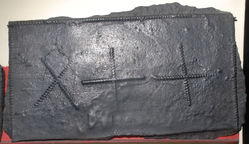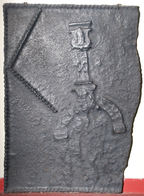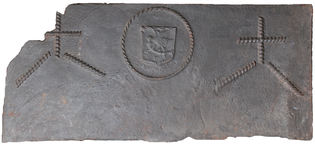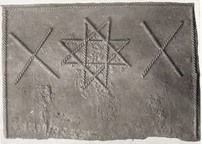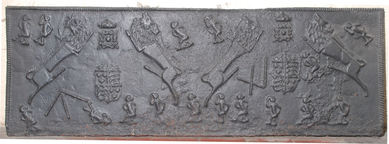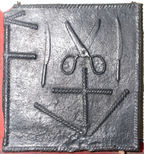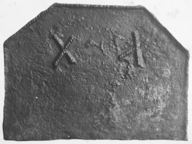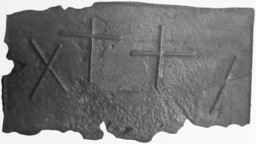-
374
Description: Quasi-rectangular; twisted rope edging (top and sides); a length of twisted rope stamped six times to form a saltire and two crosses across the width of the plate; surplus iron extends from all sides.
Notes: The surplus iron resulted from over filling of the mould. The crosses are likely to have Christian significance. Formerly part of the J. H. Every collection.
- Decoration tags:
- sub-rectangular (shape)
- rope (edging)
- simple stamps
- apotropaic
- objects
Manufactured: in the mid to late 16th century in the Weald area of England.
Current location: Anne of Cleves House, Southover High Street, Lewes, East Sussex, England.
Museum number: 1944.24.037 (part of the Sussex Archaeological Society museum group)
Citation: Hughes, G. B., May 1940, 'Old English Firebacks', Apollo, 31, 185, pp. 117-120.
- Attached to series:
- Rope design firebacks
-
378
Description: Fragment (left end only); prob. rectangular; twisted rope edging; slightly angled stamp formed of the end of a firedog with semi-circular feet, and shields at the base and top of the pilaster; V-shaped arrangement of a length of twisted rope stamped twice, the point touching the left edge of the plate and one end touching the top.
Notes: Likely to have been a triple arrangement of firedog impressions.
- Decoration tags:
- sub-rectangular (shape)
- rope (edging)
- simple stamps
- apotropaic
- objects
Manufactured: in the mid to late 16th century in the Weald area of England.
Current location: Anne of Cleves House, Southover High Street, Lewes, East Sussex, England.
Museum number: LH000.911 (part of the Sussex Archaeological Society museum group)
- Attached to series:
- Firedog stamp firebacks
- Rope design firebacks
- Metalware stamp firebacks
-
435
Description: Rectangular (damaged top left corner); plain plate; centre top, a circle of twisted rope enclosing a shield, indented at the top, charged with a bird upon a branch; on each side, a cross of twisted rope above two splayed lengths of rope.
Notes: The rope design is likely to be apotropaic; the heavily pitted reverse of this fireback shows the use of poor quality iron cast at a relatively low temperature; the bird shield stamp has been seen on other firebacks.
- Decoration tags:
- rectangular (shape)
- none (edging)
- simple stamps
- carved stamps
- apotropaic
- armorial
- objects
Manufactured: in the early to mid 16th century in the Weald area of England.
Current location: Anne of Cleves House, Southover High Street, Lewes, East Sussex, England.
(part of the Sussex Archaeological Society museum group)
- Attached to series:
- Bird shield series
- Rope design firebacks
-
437
Description: Sub-rectangular; twisted rope edging (top and sides); centre, straight length of twisted material (rope or metal) stamped eight times to form an octagram, and twice on each side to form saltires.
Notes: The octagram has magical symbolism, allegedly providing protection against evil. Formerly part of the J. H. Every collection.
- Decoration tags:
- sub-rectangular (shape)
- rope (edging)
- simple stamps
- apotropaic
- objects
Manufactured: in the 16th century in the Weald area of England.
Current location: Anne of Cleves House, Southover High Street, Lewes, East Sussex, England.
Museum number: 1944.24.038 (part of the Sussex Archaeological Society museum group)
Citation: Mercer, H. C., 1961, The Bible in Iron (3rd ed. Doylestown, The Bucks County Historical Society).
- Attached to series:
- Rope design firebacks
-
441
Description: Sub-rectangular; edged with a repeated length of helically-turned dowel (top and sides); apparently random arrangement of same piece of dowel repeated ten times, including a saltire and cross.
Notes: Apart from the Christian significance of the cross, the other arrangements of rope lengths may be apotropaic in their purpose, the double V being a possible invocation of the Virgin. The blemishes at the base are caused by the casting sand being disturbed by the pouring of the metal.
- Decoration tags:
- sub-rectangular (shape)
- rope (edging)
- simple stamps
- apotropaic
- objects
Manufactured: in the 16th century in the Weald area of England.
Current location: Anne of Cleves House, Southover High Street, Lewes, East Sussex, England.
Museum number: LH000.799 (part of the Sussex Archaeological Society museum group)
Citation: Dawson, C., 1903, 'Sussex Iron Work and Pottery', Sussex Archaeological Collections, 46, pp. 1-54.
Citation: Gardner, J. S., 1898, 'Iron Casting in the Weald', Archaeologia, 56, 1, pp. 133-164.
- Attached to series:
- Rope design firebacks
-
451
Description: Rectangular; twisted rope edging (top and sides); basic arrangement of crowned Tudor rose above a crowned Tudor royal shield, all between a crowned lion passant guardant sinister and lion passant, both per bend, repeated on both halves of the plate; irregularly arranged, mainly along the top and bottom, are sixteen small figures, alternately with right arm raised or lowered; bottom left and centre right are two different arrangements of a length of twisted rope in 'V' and 'I'.
Notes: The stamps used on this large fireback are encountered on several firebacks indicating their common source; previously at Legh Manor, Cuckfield, Sussex.
Arms: Tudor royal arms of England
- Decoration tags:
- rectangular (shape)
- rope (edging)
- simple stamps
- carved stamps
- heraldic
- apotropaic
- armorial
- animals
- humans
- objects
Manufactured: in the mid 16th century in the Weald area of England.
Current location: Anne of Cleves House, Southover High Street, Lewes, East Sussex, England.
Museum number: LH000.937 (part of the Sussex Archaeological Society museum group)
- Attached to series:
- Royal series
-
453
Description: Rectangular; twisted rope edging; irregular arrangement of three rope lengths at top left; rope cross above ‘V’ at middle bottom; impression of a pair of scissors between two impressions of a domestic table knife.
Notes: The knife is early-17th century in date or perhaps a bit earlier, just into Elizabeth I’s reign. The pommels date them from around this time and the long and narrow blades are right for the end of Elizabeth/early James I. The irregular rope lengths suggest this is probably part of a larger fireback.
- Decoration tags:
- rectangular (shape)
- rope (edging)
- simple stamps
- apotropaic
- objects
Manufactured: in the late 16th to early 17th century in the Weald area of England.
Current location: Anne of Cleves House, Southover High Street, Lewes, East Sussex, England.
Museum number: LH000.939 (part of the Sussex Archaeological Society museum group)
Citation: Moore, S., 1999, Cutlery for the Table (Sheffield, The Hallamshire Press).
-
455
Description: Canted rectangle; twisted rope edging (top and sides); a rope saltire in each top corner.
Notes: The edging is made from the same, short lengths of rope as the saltires.
- Decoration tags:
- canted rectangular (shape)
- rope (edging)
- simple stamps
- apotropaic
- objects
Manufactured: in the 16th century in the Weald area of England.
Current location: Hall Place, Bexley, Kent, England.
Museum number: 1944.24.049 (part of the Sussex Archaeological Society museum group)
- Attached to series:
- Rope design firebacks
-
1048
Description: Canted rectangular shape; twisted rope edging (top and sides); two saltires formed of twisted rope irregularly arranged.
Notes: The small size suggests a 17th rather than a 16th century date. Formerly part of the J. H. Every collection.
- Decoration tags:
- canted rectangular (shape)
- rope (edging)
- simple stamps
- apotropaic
- objects
Manufactured: in the late 16th to early 17th century in the Weald area of England.
Current location: Anne of Cleves House, Southover High Street, Lewes, East Sussex, England.
Museum number: LH000.919 (part of the Sussex Archaeological Society museum group)
- Attached to series:
- Rope design firebacks
-
1046
Description: Sub-rectangular shape; twisted rope edging (top and sides); two crosses between two saltires, all formed of straight lengths of twisted rope and irregularly arranged.
Notes: A poorly cast, and probably early, fireback. Formerly part of the J. H. Every collection.
- Decoration tags:
- quasi-rectangular (shape)
- rope (edging)
- simple stamps
- apotropaic
- objects
Manufactured: in the early to mid 16th century in the Weald area of England.
Current location: Anne of Cleves House, Southover High Street, Lewes, East Sussex, England.
Museum number: LH000.917 (part of the Sussex Archaeological Society museum group)
- Attached to series:
- Rope design firebacks
